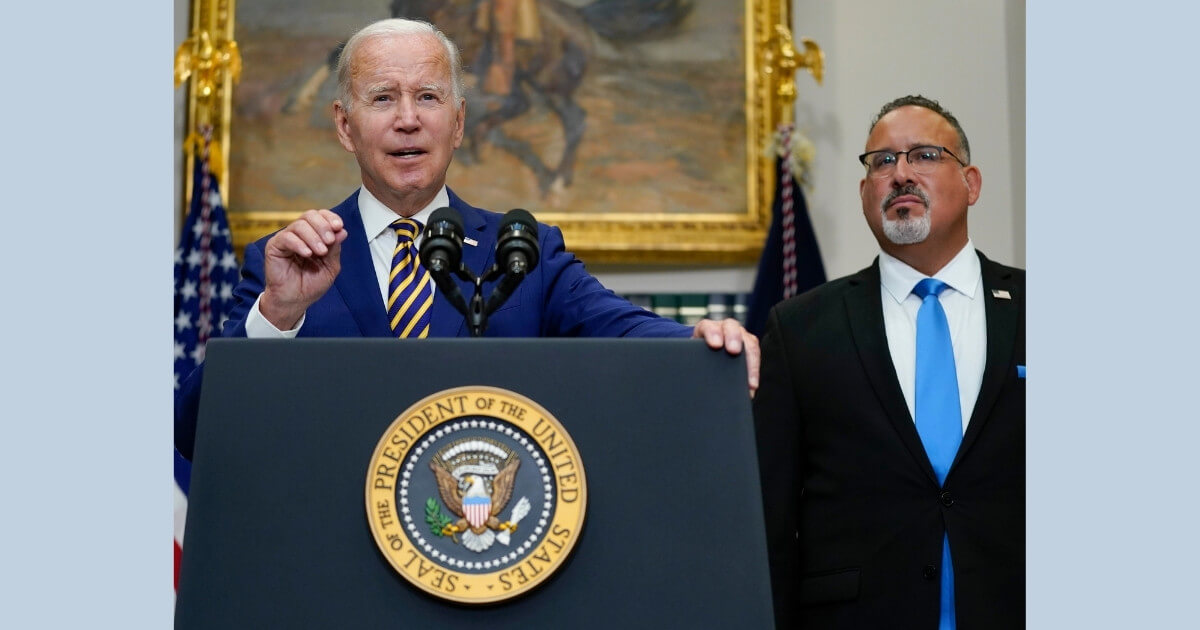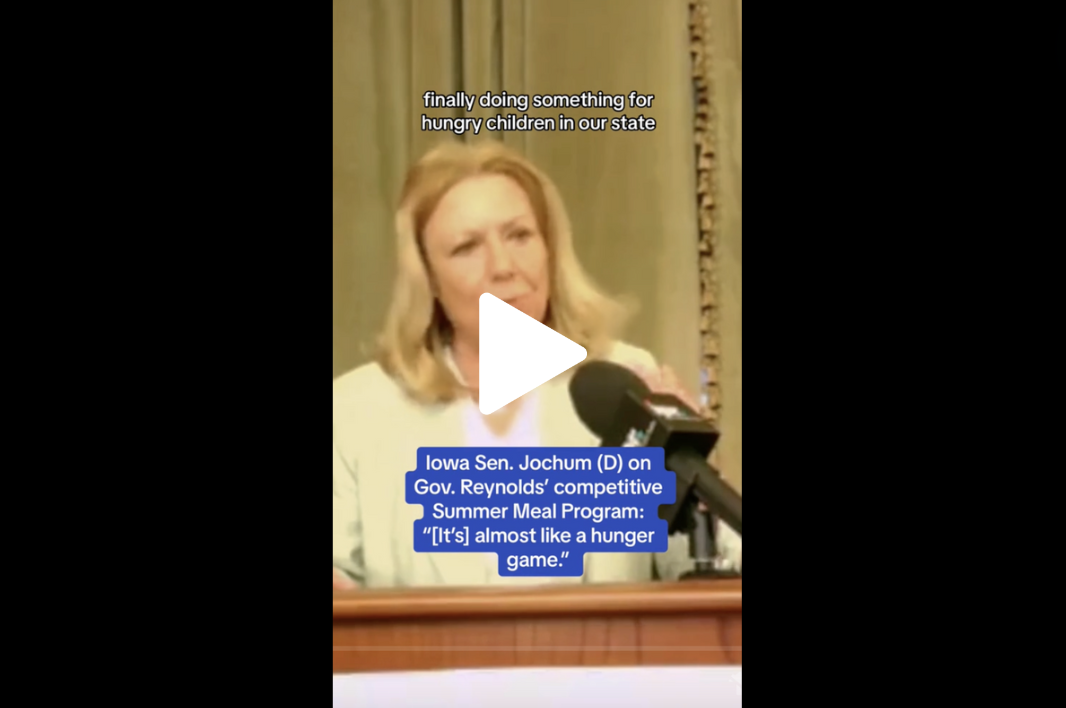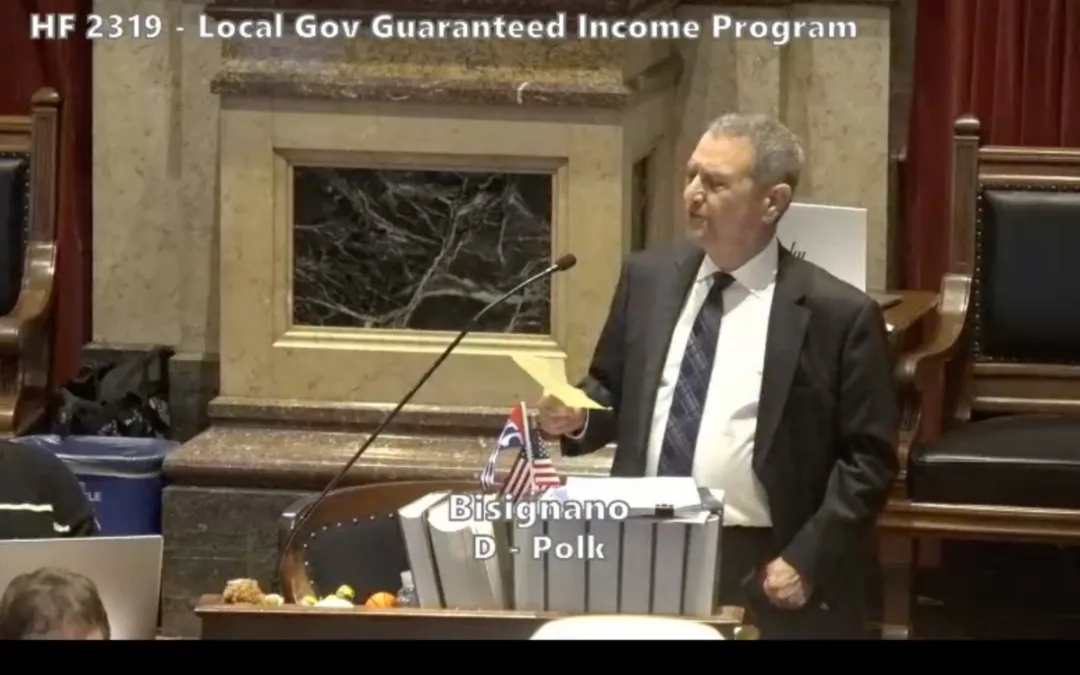
President Joe Biden speaks about student loan debt forgiveness in the Roosevelt Room of the White House, Wednesday, Aug. 24, 2022, in Washington. Education Secretary Miguel Cardona listens at right. (AP Photo/Evan Vucci)
Tens of millions of Americans received life-changing news on Wednesday, as President Joe Biden finally announced his plan to cancel federal student loan debt, extend the moratorium on student loan payments again, and make systemic changes to ensure future repayment terms are far more fair for low- and middle-income borrowers.
The announcement, which came after months of deliberation, will provide immediate relief to countless Americans who’ve struggled with the financial albatross of student loan debt and help millions of future students avoid crushing monthly payments.
According to federal data, a little more than 429,000 Iowans have about $13.3 billion in federal student loan debt.
Here’s the breakdown of Biden’s plan, which he will implement via executive order and could face legal challenges from Republicans and conservative groups who want to do nothing to address the student debt crisis.
- $10,000 in debt canceled if you went to college and earned less than $125,000 (or $250,000 for a married couple) in 2020 or 2021
- $20,000 in debt canceled if you went to college, received Pell Grants (a form of federal financial aid for undergraduate students), and meet the income threshold
- The pause on student loan payments is extended through Dec. 31, 2022, so borrowers will not have to resume payments in September.
The amount of cancellation is capped at the amount of your outstanding debt, so if you are eligible for cancellation but have less than $10,000 in debt left (or less than $20,000 as a Pell grant recipient), the cancellation will amount to whatever you owe.
[inline-ad id=”0″]
The order will apply to borrowers with federal loans from both undergraduate and graduate programs—meaning nurses and teachers will be eligible—as well as Parent Plus loans, according to the Wall Street Journal. The canceled debt will also reportedly be exempt from being taxed as income, but any loans must have originated before July 1, 2022, to qualify for cancellation.
In keeping with my campaign promise, my Administration is announcing a plan to give working and middle class families breathing room as they prepare to resume federal student loan payments in January 2023.
I'll have more details this afternoon. pic.twitter.com/kuZNqoMe4I
— President Biden (@POTUS) August 24, 2022
Current and future lower- and middle-income borrowers on income-based repayment plans will also get further relief under Biden’s new rule. The order will:
- Limit what these borrowers with undergraduate loans must pay each month to no more than 5% of their discretionary monthly income (the amount left after paying for necessary expenses like rent, utilities, and food). The rate is currently 10%, meaning Biden’s rule will effectively cut these borrowers’ payments in half.
- Guarantee that no borrower earning under 225% of the federal poverty level—roughly $30,500 in 2022—will have to make monthly payments by raising the amount of income that is considered non-discretionary income.
- Cancel loan balances after 10 years of payments for borrowers with loan balances of $12,000 or less. Currently, these borrowers are ineligible for cancellation for 20 years.
- Cover borrowers’ unpaid monthly interest, so that borrowers do not accrue any interest on their balances as long as they make their monthly payments—even if it’s as low as $0 because their income is low.
The White House provided examples of how these new rules would help different kinds of Americans:
[inline-ad id=”1″]
Biden’s move comes after years of activism from borrowers, lawmakers, and activists who have pointed out how the growing cost of college, which has roughly tripled since 1980—even after accounting for inflation—and stagnant levels of federal aid have forced students to take on burdensome loans that have now left many middle- and low-income families financially underwater and unable to start businesses, buy homes, or retire.
The average undergraduate student now graduates with roughly $25,000 in student loan debt, according to the US Department of Education (DOE). Even for those who graduate with less debt, the load can be crushing. In fact, roughly 16% of borrowers are in default—including roughly 750,000 senior citizens with student debt—which can result in the government garnishing a borrower’s wages or lowering their credit score.
Biden’s order is expected to provide direct financial relief to a substantial majority of the 43 million Americans with $1.6 trillion in federal student loan debt—nearly one-third of whom never finished their studies or obtained a degree due to the high cost.
[inline-ad id=”2″]
Under the rule, an estimated 20 million people are expected to be eligible to have their remaining debt fully canceled, with benefits overwhelmingly flowing to Americans earning less than $75,000 per year.
The move is likely to be a popular one among ordinary Americans. Recent polling from Courier Newsroom and Data for Progress found that 58% of likely voters supported canceling at least $10,000 in federal student loans, with 63% supporting the same amount of cancellation for low- and middle-income borrowers.
According to the DOE, nearly 8 million borrowers may be eligible to receive automatic relief because relevant income data is already available to the agency. If the DOE does not have your income data, or if you’re unsure if they do, the Biden administration will be rolling out an application in the coming weeks, before the pause on federal student loan repayments ends on Dec. 31.
[inline-ad id=”3″]
You can sign up for email notifications from the Department of Education once the applications are open.
Borrowers who work for nonprofits, the military, or federal, state, local, or Tribal governments may be eligible to have all of their federal student loans canceled through the Public Service Loan Forgiveness (PSLF) program because of temporary changes to the program’s eligibility criteria. These changes expire on Oct. 31, 2022. For more information on eligibility and requirements, visit PSLF.gov.
by Keya Vakil
08/25/22
[inline-ad id=”4″]
Iowa Starting Line is part of an independent news network and focuses on how state and national decisions impact Iowans’ daily lives. We rely on your financial support to keep our stories free for all to read. You can contribute to us here. Also follow us on Facebook and Twitter.
Politics

Biden marks Earth Day by announcing $7 billion in solar grants
The Biden administration on Monday announced the recipients of its Solar For All Program, a $7 billion climate program that aims to lower energy...

6 terrifying things that could happen if the Comstock Act is used to target abortion
Does 1873 sound like a really, really long time ago? Well, that’s because it is—but if Republicans and far-right anti-abortion activists have their...
Local News

No more Kum & Go? New owner Maverik of Utah retiring famous brand
Will Kum & Go have come and gone by next year? One new report claims that's the plan by the store's new owners. The Iowa-based convenience store...

Here’s a recap of the biggest headlines Iowa celebs made In 2023
For these famous Iowans, 2023 was a year of controversy, career highlights, and full-circle moments. Here’s how 2023 went for the following Iowans:...






